Ryan Hall's Blog, page 276
March 22, 2016
How You Can Learn to Run With Mindfulness
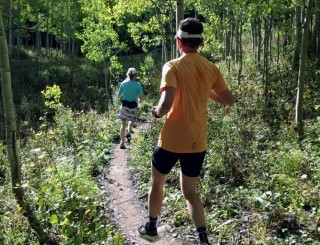
Learning to run with mindfulness means paying attention to how your body, mind and emotions are responding to training and racing. Photo: Brian Metzler
Josh Weinstein will never forget the first time he saw marathoner and master meditator Sakyong Mipham Rinphoche. It was during a class at Naropa University in Boulder, Colo., where Weinstein, a runner and former backcountry ski touring guide, was enrolled in a masters of divinity program. The Sakyong (an honorary term meaning “earth protector”) poked his head through the classroom door.
“I was immediately struck,” Weinstein, 46, said recently. “It is hard to describe. He felt like an old friend. There was something about him.”
That ineffable “something” is what Weinstein and others call “mindfulness,” a somewhat nebulous term that has gained national foothold in recent years. We certainly know when we meet a “mindful” person; he or she exudes a calmness, a sense of being grounded and connected that is appealing.
Sakyong Mipham Rinpoche is one such runner. His father, Chogyam Trungpa, helped bring Tibetan Buddhism to the West and founded Naropa in 1974. Sakyong is a meditator-turned-3-hour marathoner.
While he was an early advocate of “Running with the Mind of Meditation”—the title of his 2011 bestseller (No. 17 on Competitor’s list of the Best Running Books of All-Time)—and of an annual eponymous Labor Day retreat at the Shambhala Mountain Center in Red Feather Lakes, Colo., others in the nascent movement are runners-turned-meditators.
Examples include Michael Sandler of barefoot running fame and ultrarunning star Timmy Olson. He leads a popular retreat called “Run Mindful,” while Elinor Fish also leads mindful running retreats.
Other runners who incorporate meditation—a path to mindfulness, which can be defined as non-judgmental “noticing” or “paying attention to”—include ultra legend Scott Jurek, 1992 Olympic bronze medalist Lorraine Moller, and former prep star Melody Fairchild.
Do not, however, think that “mindfulness” is something new. Despite its current popularity in the national media. the best long-distance runners have always run with a “mind of meditation,” although they might not have called it so. They had; otherwise, they would not have become champions.
Arturo Barrios was not the best collegiate runner while attending Texas A&M in the early 1980s; he admits he would not have later become a five-time world-record holder and finished fifth in the 10,000-meter run at the 1988 Olympics if he had not run “mindfully.”
What does that mean? The term has become a social meme, springing up in daily conversations, from eating mindfully to parenting mindfully to living mindfully. In Barrios’ case—and for other runners who make it to the top—it simply means paying attention to how their bodies, minds and emotions are responding to their training and racing and how all three are intertwined.
And, of utmost importance for runners, accepting our feelings, thoughts, emotions and not trying to force or “effort” our way through a workout or a race.
RELATED: Is running meditation?
Being mindful is what Jurek was doing when he changed his diet and his training on his way to becoming a seven-time Western States 100 winner. And two-time U.S. Olympian Alan Culpepper was being mindful when he decided to skip recovery day runs with fellow elites Adam Goucher and Jorge Torres and run on his own, in order to run the pace he felt he needed.
Weinstein, program development manager of the new “Runing with the Mind” online course, is codifying the many disparate tenants of running, yoga and meditation, all part of what he calls “the emerging movement in mindful athletics.”
“Running with the Mind” recently launched a Kickstarter campaign that continues through the end of the month. Weinstein said the goal of launching “Running with the Mind” was to bring the Sakyong’s teachings to the millions of runners who are not able to attend his yearly retreats. (Competitor readers can get an 85 percent discount on the premier of the seven-week online course by pledging $25 to the Kickstarter and then sending the code “Competitor Magazine” via the “contact me” link.)
Those teachings, whether at a retreat, in the book “Running with the Mind of Meditation,” or in the new online course are simple, yet powerful. One is that just as we need to build a base of aerobic training, so do we need a base of meditation. Even a master teacher as Sakyong Mipham had a wandering “monkey mind” in his early years of learning meditation from his father.
It took years of meditation—the Tibetan word for which is “gaining familiarity with”—for Sakyong Mipham to reach a state of mindfulness in all aspects of life, as much as possible.
Again, what does “being mindful” in life mean? Simply “being present,” focusing on what you are doing right now, whether writing an article, running a trail, talking with your child or your partner, or shooting a free throw.
You accept what has taken place in the past, without judging it, and do not fret about the future, the next race or workout, for example. Rather, it is a focus on “the power of now.”
RELATED: Why You Should Attend a Holistic Running Renewal Retreat
“I had read about mindfulness, but until you see someone living it, it is just an idea,” Weinstein said in explaining the instantaneous connection he felt upon first seeing Sakyong Mipham. “He was already on the path. It opened the door to the possibility of really learning from someone else.
Weinstein said there are many teachers out there; he was ready when the Sakyong appeared, just as you will be.
“Mindfulness can be very internal, and when I saw someone really awake, it made the possibility of sharing the experience. There is someone doing what I want to do. It was that kind of inspiration.”
For more about Running with the Mind and hear testimonials about the program, go to rwtm.org.
The post How You Can Learn to Run With Mindfulness appeared first on Competitor.com.
Photos: From Coast to Crater, an Endurance Adventure on Maui
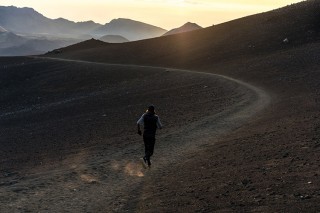
“Boundless” is a show on the Esquire Network that follows hosts Simon Donato, Paul “Turbo” Trebilcock, OCR athlete Hunter McIntyre and ultraunner Rory Bosio as they compete in endurance adventures around the world.
Recently, while training for the show, Donato went to the Hawaiian island of Maui where he teamed up with McIntyre, Bosio and Max Wilcocks for an epic challenge they called the Maui Wowee.
The group started at the Pacific Ocean near Paia, Hawaii and rode bikes to the summit of Haleakala, the massive volcano that makes up a large portion of the island. They then dropped the bikes off and ran a lap around the Haleakala crater, before grabbing their bikes and riding back down to the ocean. In all, the three covered 90 miles on the day, including 17 miles of running. It took 13 hours and 30 minutes.
Here are photos of their challenge, taken by Liz Barney. The third season of “Boundless” kicks off on April 12th and will include endurance challenges in the U.S., Greenland, France, Sweden, Canada and more.
Photo Gallery
1 of {count}
Back to Start
View Larger Image

The day before the challenge, the crew visited Haleakala and checked out the crater trail.
View Larger Image

Another shot from the crater trail the day before the challenge.
View Larger Image

Riding toward the crater.
View Larger Image

Riding toward the crater. In all, the ascent totaled 10,000-plus feet of elevation gain.
View Larger Image

The four rode to the 10,023-foot summit before dropping 3,000 feet over 3.75 miles into the crater. There, they ran a lap around the crater.
View Larger Image

Circling the crater.
View Larger Image

The Haleakala crater is within Haleakala National Park.
View Larger Image

All told, there were 17 miles of running.
View Larger Image

The team gets back on the bike and heads back to the ocean.
View Larger Image

Done! Beer was in order after the 90-mile journey finished at the beach.
View Larger Image

Related Galleries

Photos: Big Island Scenery at the Kona Marathon

Photos: The 2015 Hapalua, Hawaii’s Half Marathon

Photos: Running Kauai’s Nā Pali Coast

2009 XTERRA Trail Running World Championships Photo Gallery

More Galleries
The post Photos: From Coast to Crater, an Endurance Adventure on Maui appeared first on Competitor.com.
March 21, 2016
Why the Kettlebell is a Great Tool for Runners
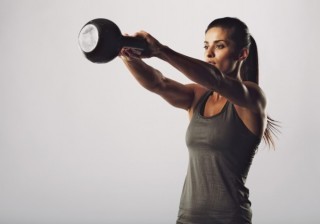
This article first appeared on Women’s Running.
If you’re only logging miles and skipping the strength sessions, consider kettlebells. In other words, swing, squat and snatch your way to perform your best at your next race.
Kettlebell training, an interval-style workout that uses explosive power with weight, can help you boost your running performance in as little as 30 minutes per workout—and it doesn’t require much equipment, space or time. But first, here are the basics:
What is a kettlebell?
A kettlebell is a weight that has a unique offset center of gravity.
What’s the difference between a kettlebell and dumbbell?
Dumbbells have weight equally balanced on each side. A kettlebell’s weight is distributed in the center.
“The kettlebell’s design allows you to swing it back between your legs, unlike a barbell or dumbbell, allowing for controlled speed during the exercise and utilizing the most powerful muscles of the body [legs, glutes, back] to dynamically propel the kettlebell forward,” says Joseph Morstad, a two-time triathlete, author and fitness and nutrition coach.
How does kettlebell training actually boost running performance?
This style of training increases cardiovascular health without putting too much strain on your muscles. The explosive, quick movement that’s required during kettlebell training boosts your heart rate, strengthening cardiovascular health while increasing muscle strength, posture and core—all essential elements to improve your running performance. Kettlebell training allows you to maximize your workout effort in a short amount of time. In other words, you conserve energy while increasing strength and speed.
Other benefits you can gain from kettlebell training include:
Improved overall body strength, specifically glutes, hamstrings, core, back muscles
More mobility—the better you move, the easier you can run and the faster you run
Boosted endurance and stamina—you can go farther much easier
Increased work capacity
Better running posture and stride
Morstad goes on to explain the benefits specifically related to one of the most underused muscles in runners: the glutes.
“Stronger glutes can promote better ankle, knee and hip alignment, helping women runners [specifically] prevent inward knee collapse,” explains Morstad. “A stronger core allows for more upright running posture, better breathing and easier/smoother stride.”
RELATED: 5 Kettlebell Exercises for Runners
The post Why the Kettlebell is a Great Tool for Runners appeared first on Competitor.com.
Indoor Track Shows Its Potential in Spectacular Form in Portland
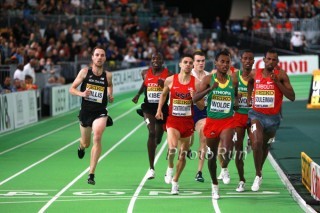
Photo: PhotoRun.net
There were moments on Saturday evening and Sunday afternoon at the IAAF World Indoor Championships of track and field in Portland, Ore., that make you optimistic about track’s uncertain future in the United States. Races where the intimate crowd packed tightly inside the Oregon Convention Center around a gorgeous 200m track purpose-built for this occasion reached deafening levels. It was one of American track’s finest weekends ever, in fact, having won the most medals ever by any country in these biennial, offseason championships.
Moments like an 800m final that American Boris Berian, a one-time track prodigy dropout who was working at McDonald’s little more than a year ago, led wire to wire. Or the men’s 1500m final, an epic duel in which world-class American Matthew Centrowitz Jr. bested his longtime rival, the New Zealand veteran Nick Willis. Or the women’s high jump, where high schooler Vashti Cunningham, daughter of former NFL quarterback Randall Cunningham, beat a strong field to win a world championship gold medal at age 18.
RELATED: Boris Berian’s Unlikely Road to World Champion
Or try this example for how good the vibe at this track meet was: The arena unexpectedly exploded in rapture when American Michelle Carter heaved the final, winning throw in the women’s shot put. Seriously. Women’s shot put.
If anything, it proved that indoor track is something that any sports fan would enjoy. The intimate, walled-in venue seems to amplify track and field’s strongest traits. All the drama of racing, and the awe-inspiring spectacle of people jumping high or far, is pressurized, condensed and boiled down inside a building: The races are shorter, the track is smaller, the fans are closer, and the four walls and low ceiling hems in the energy and the noise.
And yet, even on one of America’s finest recent track weekends, it was predictably overshadowed by the NCAA basketball tournament that’s on simultaneously.
RELATED: Americans Finish Strong at World Indoor Championships
Because these were races that make you think that if only American sports fans could see this, maybe they’d come back to the sport en masse. The U.S. won 23 medals, a new championship record—13 of them gold. And not only that, the arena truly felt as frenzied as an NCAA basketball tournament game.
These are not good days for track and field. It’s been completely left behind in the SportsCenter age, unable to elevate stars or storylines into the American sporting consciousness as it once did. The blame lies both with the sport and its lecherous ancillary organizations. Recent bribery scandals at the IAAF, track’s governing body, make FIFA and the IOC look like honorable institutions in comparison. And each subsequent athlete doping scandal reveals that performance-enhancing drugs are far more pervasive than previously assumed, with athletic federations even colluding to play a part in abetting and covering them up. In fact, all Russian athletes were banned from the meet for this reason. Meanwhile, broadcasters can’t seem to portray track and field with any of the polish or production values that fans of football, basketball or baseball take for granted, far below the basic standard for sports coverage in the 21st century.
So let’s just say it: Track has a long road back, and everyone in the sport knows it.
And so Portland’s hosting of this year’s biennial world indoor championships was seen as something of a cautious first step back into American sports fans’ attention span. Stakes were quietly high, in other words, for this thing to be a success.
With this in mind, the track meet’s organizer, Vin Lananna, with IAAF president Sebastian Coe’s blessing, set out to make this unlike any indoor track meet ever seen before: Athletes entered the arena pro-wrestling style, via a tunnel, accompanied by music, swirling spotlights and fog machines. The program was tweaked to play up certain events. And the medal ceremonies became a public spectacle free to anyone, held not in the arena but across the river in Pioneer Square, the main gathering area in Portland’s downtown.
Was it a success? Well, we should probably measure success in this embattled sport in small increments these days, but let’s say there was cause for optimism. American success here bodes well for the summer Olympics later this year. And after reports of slow sales when tickets first went up for grabs last year, in the end, Friday evening, Saturday evening, and Sunday’s programs were each sellouts, with more than 7,000 people encircling a 200m track and screaming loud. Saturday night’s medal ceremony downtown in Pioneer Square reached capacity—people inside had to leave before anyone else outside was let in. These are all good signs for Lananna’s long-range plan to first make the state of Oregon a stronghold for the sport, then grow outward.
“I think this is the start,” Lananna said at a press conference on Sunday. “I don’t think everything can happen all at once. I think what we have created is a valuable show. The entertainment has been really good, and it is like anything else: People come to something and feel like it’s the place to be, then it is easier to transport to other places.”
However, I was reminded of one of track’s biggest weaknesses when I watched recorded TV coverage later in the evening. Obviously, most sports are better in person, but the visceral thrill of racing, jumping and throwing gets somewhat lost in the TV broadcast. All of the tension, the screaming, the whistling and the drama that reverberated around the arena during Berian’s electrifying 800m final on Saturday night was lost on TV. There, the race sounded like a quiet practice session in comparison. And so having TV be one of the sport’s weakest links is dispiriting, particularly after all of the attention paid by Lananna to create a festive, Roman Colosseum-like atmosphere and some wider public awareness.
But in all, being here in person at the IAAF World Indoor Championships offered a bit of hope for the sport as it crawls its way back to respectability: The American track team is loaded with talent—and great storylines just begging for profiles by Bob Costas at the Olympics. And Lananna can be trusted to put on a great spectacle, which is good news because he’s got many more up his sleeve. He’s also starting up what’s known as the Summer Track Series between the Olympic Trials and the Olympics this year, with an innovative team format, track meets in several cities and a broadcast deal with ESPN. He’s also once again putting on the Olympic Trials in Eugene, Ore., will serve as head coach for the U.S. Olympic track and field team this summer, and last year helped win an unbelievable bid for Eugene to host the 2021 outdoor world championships. He’s the right guy to lead any sort of charge, in other words.
Can track ever put its best foot forward? It’ll take far better media treatment, plus a hole in the sports calendar not filled with a cultural phenomenon like March Madness.
But was this a good first step back to relevancy for track and field in the United States? Absolutely. There’s plenty of work to do on the media’s presentation. And if track ever does grow back into a vital American sport, it certainly won’t be overnight. But as Portland’s hosting of these world championships showed, the actual sport is as exciting as ever, particularly indoors. The only thing is that for now, at least, even in our media-saturated age, you’ll just have to see it in person.
The post Indoor Track Shows Its Potential in Spectacular Form in Portland appeared first on Competitor.com.
Million-Dollar Prize Up For Grabs On “The Runner”

A million-dollar prize is up for grabs in a unique interactive reality competition series called “The Runner,” a project dreamed up by Academy Award winners Ben Affleck and Matt Damon that has been 16 years in the making.
“The Runner,” which will launch this summer and best hosted on Verizon’s new go90 platform, follows a runner who will try to make it across the U.S. over the course of 30 days. The catch? Eight teams, each made up of two “chasers,” along with at-home viewers, will try to locate and capture the runner using tips, clues and technology.
“Somewhere in the United States, a mysterious runners will be racing toward an undisclosed city,” according to the show’s website. “That runner will be hunted by competing teams of chasers. It is up to the runner to use strategy and determination to avoid the chasers and make it to the target city. The task of the chasers is to find the runner before time runs out… or another group of chasers beats them to it.”
At stake for the runner and chasers, according to a press release, is a million-dollar prize. Also, Verizon go90 users who provide tips, sightings and evidence of the runner’s location are also eligible to win money.
Interested runners and chasers can apply via the show’s website. “You do not need to be an athlete or have experience with endurance events/sports to apply for the roles of runner or chasers,” according to the website. “You do, however, need to be reasonably fit to keep up with the pace of the show.”
The post Million-Dollar Prize Up For Grabs On “The Runner” appeared first on Competitor.com.
Boston-Bound: One Month To Go Until Race Day!
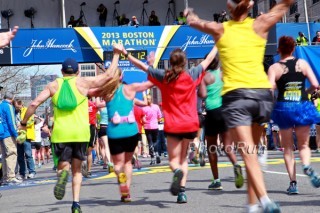
Photo: PhotoRun.net
There’s one month to go till the Boston Marathon! Just reading that sentence probably causes a shot of adrenaline. I know it does for me and I’m very much looking forward to getting to Boston and cheering for you.
This article outlines the last two big weeks of the training cycle before you begin the peaking phase for the big day. At this point, you should have your race nutrition dialed in. You should know what you will eat the night before, morning of and during the race. You should also have tried and tested your race day equipment—even planning for different weather conditions. And, you’ll want to have your race morning timeline sketched out. Know every detail from the time you’ll wake up until the race starts. The goal on race day is to be on auto-pilot and keep stress levels low.
Week 9
Similar to Week 7, what you do early in Week 9 depends on how you recovered from last weekend’s fast finish long run (or race). If you recovered quickly and are used to a higher training load (i.e., two challenging workouts per week plus a long run), then do a longer run early in the week. If you are a lower training load athlete (i.e., one challenging workout per week plus a long run) or are still tired from the fast finish long run or race, then run shorter. No one ever got injured from an extra day of recovery but many do from pushing too hard, too soon.
Workout No. 1 (recovered runners, early in week): Medium Long Run. Run 1:30-1:45 over a hilly route.
Workout No. 1 (unrecovered runners, early in week): Easy Run. Run 40-60 minutes on a flatter route.
Workout No. 2 (later in week): Tempo Run. Warm up with 10-20 minutes of easy jogging, then run 35-50 minutes at your tempo run pace. Ideally, you’d find a course that mimics the Boston course (i.e., mostly downhill, a hill or two later in the run then a downhill finish). Cool down with 10-20 minutes of easy jogging. A good sign on this run is if you feel very smooth and fluid. As mentioned in Week 6, the tempo run is designed to push your lactate threshold faster and help you run smoothly at a medium-hard effort.
Long Run: 2:30-3:30 for sub 3-hour marathoners (22-26 miles); 3:14-3:45 for 3+ hour marathoners (18-22 miles). Note: Run this over a hilly course and surge slightly on the downhills to practice your downhill running.
Week 10
For the bulk of the training plan, you’ve been building fitness. In Week 10, you begin to refine race fitness. You’ll do two key workouts that are less about running faster and faster but are more about hitting goal race pace as relaxed as possible. You’ll do a goal pace run in the middle of the week, then your last fast finish long run on the weekend. Both put the finishing touches on your fitness and I want you to focus on running these as relaxed as possible.
Workout No. 1 (mid-week): Marathon-pace Run. Warm up with 10-20 minutes of easy jogging, then run 7-10 miles at goal marathon pace. Again, find a course that mimics the Boston course. Cool down with 10-20 minutes of easy jogging. This is a great workout to practice using your equipment and dial in your nutrition plan (night before, pre-run and during run).
Workout No. 2 (advanced runners): Progression Run (early in week). Run easy for 80-90 minutes with the last 10-20 minutes at a slightly faster pace (around tempo effort).
Long Run: Fast Finish Long Run. 12-16 miles (intermediate runners) or 14-18 miles (advanced runners) with the middle 6-8 miles at goal marathon pace and the last 1-2 miles slightly faster. Cool down with 5-10 minutes of easy jogging.
The post Boston-Bound: One Month To Go Until Race Day! appeared first on Competitor.com.
Photos: 2016 Rock ‘n’ Roll Mexico City
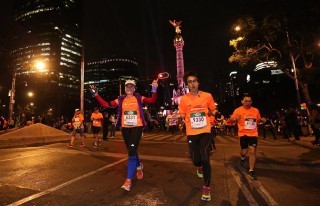
The 2nd annual telcel Rock ‘n’ Roll Mexico City Half Marathon took place Sunday night in Mexico’s capital city, a 13.1-mile race/celebration.
The nighttime race started on the race track Hipódromo de las Américas, before runners toured the city, cutting through Chapultapec Park, then running on a raised freeway with panoramic views of the city lights. Runners return to the race track and run by the headliner concert stage before finishing, wrapping up a festive night.
Here are photos, taken by Steve Godwin:
Photo Gallery
1 of {count}
Back to Start
View Larger Image

View Larger Image

View Larger Image

View Larger Image

View Larger Image

View Larger Image

View Larger Image

View Larger Image

View Larger Image

View Larger Image

View Larger Image

View Larger Image

View Larger Image

View Larger Image

View Larger Image

View Larger Image

View Larger Image

View Larger Image

Related Galleries
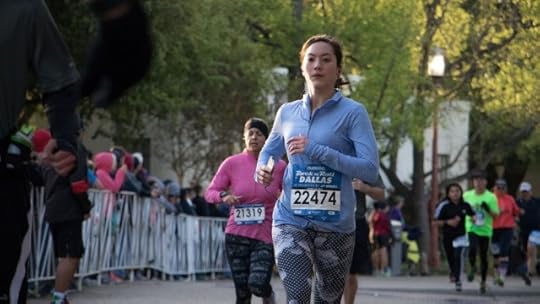
Runners Rock the ‘Big D’

Photos: 2016 Humana Rock ‘n’ Roll New Orleans
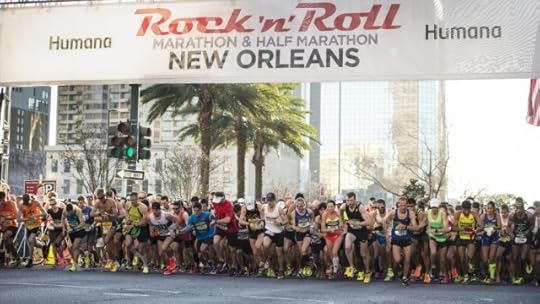
Runners Rock the Big Easy

Photos: 2016 Disney Princess Half Marathon

More Galleries
The post Photos: 2016 Rock ‘n’ Roll Mexico City appeared first on Competitor.com.
Americans Finish Strong at World Indoor Championships
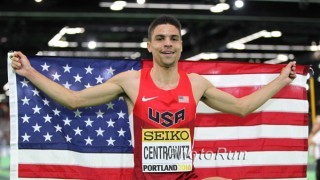
Photo: PhotoRun.net
(c) 2016 Race Results Weekly, all rights reserved. Used with permission.
PORTLAND — American distance running history was made on the final day of competition here at the IAAF World Indoor Championships, as the red, white, and blue took home a total of four medals over four events contested. Portland area resident and University of Oregon alum Matthew Centrowitz thrilled the capacity crowd with a scintillating come-from-behind win in the 1500m, while fellow Portlander Ryan Hill used the crowd’s roar to propel himself to silver over 3000m. For the women, Ajee’ Wilson and Shannon Rowbury were second and third in their respective events, giving the USA a record haul of medals over disciplines 800m and up.
The men’s 1500m was the most anticipated match-up leading into the final day’s competition, as Centrowitz squared off against Olympic medalist Nick Willis of New Zealand and reigning world indoor champion Ayanleh Souleiman of Djibouti. Jockeying for position, all contenders were in the mix through the opening kilometer. Souleiman seemed to have the advantage, while Ethiopians Aman Wote and Dawit Wolde threw their hats into the ring staying towards the front.
Out of nowhere, Willis stepped on the gas and transitioned to a full-out sprint with 400 meters to go. The 32-year-old Kiwi took much of the field by surprise.
“My wife [Sierra] and I said we do not, even if I finish third, we do not want the fastest part my race to be the last 100m. So often in my career I’ve saved it wondering ‘what if.’ Today there wasn’t going to be a what if. It was going to be put it out there and if they pass me in the last 50 so be it,” said Willis.
Over the bell lap, the Oregon Convention Center’s volume reached record level, as 7,191 strong stood and willed Centrowitz—the Nike Oregon Project athlete who lives a mere 15 minutes away—to the front. Rounding the final bend Centrowitz tracked down Willis and threw himself to the front. He’d cross the line first in 3:44.22, steps ahead of the Czech Republic’s Jakub Holusa, who nipped Willis at the line 3:44.30 to 3:44.37.
“I knew it was going to be physical, but compared to the prelim I had two days ago, I wanted to put myself in a better position,” Centrowitz said after becoming the first American man ever to win 1500m gold in meet history. “I figured with two or three laps to go no one goes by me [on the outside]… It kind of replayed like Millrose Games. You know, I just said to myself ‘you’ve been in this position before, stay relaxed, Nick’s going pretty hard, and just use the crowd to my advantage that last lap.'”
Completing the indoor season undefeated, Centrowitz reflected on the signature battle between him and Willis and what it means to claim another global medal, especially on home soil.
“I just thought of how bad I really wanted it. Didn’t want to disappoint everyone here, all of the American fans and my family and friends. It was awesome,” he said. “I’m just going to [let this] sink in, add this to my collection, and now I have one of every color [gold at world indoors, silver and bronze at world outdoors]. Now it’s just time to go get an Olympic medal.”
Closing very hard in the last lap was American teammate Robby Andrews, who wound up fourth in 3:44.77. Souleiman, the reigning champion, wound up last in the race in 3:53.69. He was wheeled through the mixed zone on a stretcher.
“Dang, I wish I had been closer to the front,” said a smiling Andrews. “I think if I had been a little closer, yeah [I’d be in medal contention]. I don’t know. Never mind.”
He added: “I’m so happy for [Matthew]. I mean, you want to see USA on the top of the podium for sure. He’s clearly the best in the world right now, and I’m really happy for him. We’re one team right now, in a couple months it’s a different story. But right now I’m really happy for him.”
Hill Sprints for 3000m Silver
From start to finish, the men’s 3000m was a chess match, or better yet an aggressive cat and mouse battle. In particular, the final two kilometers were a battle royal.
With frantic frequency, surges where thrown like sucker punches by the might of East Africa: Isiah Koech led, then Augustine Choge, and Caleb Ndiku responded with a burst of energy, going from the tail end of the pack to the head.
Yet it was the youngest athlete in the field, Ethiopia’s Yomif Kejelcha, throwing down the gauntlet with 400 meters to go. Proving himself a potent racer last outdoor season, Kejelcha ran with the confidence of a seasoned veteran; he’d swiftly take the lead and not cease control.
Down the stretch, Kejelcha was out in front by three steps and crossed the line first in 7:57.21. Yet all eyes were on the hard-charging American Ryan Hill, who went from fifth at the bell lap to the silver medal, passing Kenya’s Choge in the final meters. Hill’s final time was 7:57.39. Had the race been 10 meters longer, he could have nabbed gold.
“Before this race, my best world finish was seven, so to come back with a second, it’s really hard to complain about,” said Hill, who before the meet thought a top-five performance would be acceptable.
Kejelcha, whose official age is only 18, gave Ethiopia the first of two gold medals on the day. “I didn’t know I could do this well indoors. I was just following my rivals throughout the race. And I’m very happy I could win.”
In the mixed zone, Hill second-guessed himself for not going to his sprint earlier. He thought coach Jerry Schumacher would chastise him for the mistake.
“I knew exactly what was happening, I just wasn’t good enough to –mentally good enough or physically good enough– to cover all those moves. I had to settle for sitting back,” he said. “I never stepped out of lane one so I had plenty of kick left. And that’s basically how I got second, three of those four guys died… It probably shows that I had the wheels to win, just need a little more confidence if I get in that situation again.”
Giving commentary in the NBC Sports Network television booth, double Olympic gold medalist Mo Farah was impressed by Hill’s race.
“Congratulations to Hill, that really is a great race for him to get second,” Farah said, shaking his head with conviction. Behind Hill, Choge took home the bronze in 7:57.43. American Paul Chelimo was seventh in 8:00.76.
In 2nd Indoor Race Ever, Niyonsaba Holds Off Wilson
Yesterday, Francine Niyonsaba ran the first indoor 800m race of her career. Today, in her second, she was crowned world indoor champion.
American Ajee’ Wilson went to the front in her usual style and split 200 meters in 29.23 seconds with towering Kenyan Margaret Wambui hot on her heels. Wambui, whose stride is twice the length of Wilson’s, moved up to the pole to split 400m in 60.56.
A second later, though, Niyonsaba took control with a bold and decisive move that could have come back to bite her in the final circuit. Inexperienced on the indoor oval, the 22-year-old from Burundi had not faced the burning sensation that the indoor oval tends to give half milers.
Niyonsaba began to slow her tempo ever so slightly on the backstretch and out of the final turn, just as Wilson began her sprint for home. Wilson got by Wambui for second place, though simply ran out of real estate tracking down Niyonsaba. In a world leading 2:00.01, the gold went to Niyonsaba.
“I have a good coach, I have a good team. Much motivated, that is why I won,” said Niyonsaba, who gave Burundi their second 800m medal of the meet (Antoine Gakeme won silver in the men’s 800m on Saturday). “I think Burundian people remember this night.”
Wilson was pleased with second place, though wanted to add another gold to America’s medal tally.
“I wasn’t prepared for Francine to come up when she did, I just didn’t react fast enough and I kind of waited too late to make my charge. Silver is what I get for that,” she said. “I’m really happy about that. I find myself in a weird position: in 2013 outdoors just making the final I was happy to be there. And then now silver is great, but I wish I would have been able to walk away with gold.”
Dibaba Runs Away With 3000m Gold; Rowbury Gets Bronze
As many fans expected, Ethiopian starlet Genzebe Dibaba ran away with the women’s 3000m, clocking a time of 8:47.43 to win the third world indoor title of her career. Aware of her competition, Dibaba made a calculated move to surge from last to first midway through the race, giving herself a sizable lead.
“I’m very happy with this performance. I ran a lot of it alone, I was feeling very strong,” said Dibaba. “I am a little disappointed that I was unable to double with the 1500 meters because the 3000 meters ended up being a straight final, and I would have liked to have tried both. I did run alone after the first kilometer, and it was easy and I felt very comfortable and I’m very happy.”
Behind Dibaba, the race for second would be up for grabs. Fellow Ethiopian Meseret Defar battled with American Shannon Rowbury and Dutchwoman Maureen Koster. Despite closing hard within the last circuit, it was Defar –in her first major championships since giving birth to daughter Gabriella– holding off Rowbury for silver, 8:54.26 to 8:55.55.
“It’s been since 2009 that I’ve gotten a medal. I’ve had some good performances, most recently setting the American record in Monaco last year. Championships don’t come around very often, and to be able to bring home a medal at home was something I was really striving for, and I’m proud I accomplished it,” said Rowbury, who also lives in Portland.
Knowing the results of the earlier competition gave Rowbury an extra dose of adrenaline needed to power through the final laps.
“I’ve become so used to competing far away for a foreign crowd, so this is the first time in my career that I’ve gotten to compete at home [for a world title]. The crowd support and fan support was palpable, and leading up to this race, ever since the first day of the championships America’s been bringing home medals,” she said. “Right before I came out here I watched the men’s 3000m and we got silver, the women’s 800 we got silver, and I knew my teammate was up next so I wanted to keep that momentum going. I felt very confident that I could be on the podium and bring home a medal for the US.”
Rowbury’s teammate, Abbey D’Agostino, closed hard to finish fifth in her first IAAF World Indoor Championships in 8:58.40.
On home soil, America topped the medal count with a championships record 23 medals, 13 of them gold (also a record). Distance events counted for six of the total medals, with two gold, two silver, and two bronze.
The four day total attendance for these championships was 39,283. The next IAAF World Indoor Championships will be held in Birmingham, England, in 2018.
The post Americans Finish Strong at World Indoor Championships appeared first on Competitor.com.
March 20, 2016
Americans Take Gold, Bronze In Men’s 800m Final At IAAF World Championships
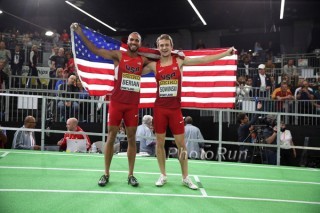
Boris Berian and Erik Sowinski celebrate their medal performance on Saturday night. Photo: PhotoRun.net
(c) 2016 Race Results Weekly, all rights reserved. Used with permission.
PORTLAND, ORE. — March Madness is generally a term reserved for basketball in the United States, yet it could fittingly describe Saturday night’s competition at the IAAF World Indoor Championships. For the first time in history, the United States claimed multiple medals in a men’s 800m final, as Boris Berian won his first world title in 1:45.83 and Erik Sowinski came from behind to capture bronze in 1:46.65. Burundi’s Antoine Gakeme won silver, denying two-time gold medalist Mo Aman a medal.
In a Cinderella story that is film-worthy, Berian went from working in a McDonald’s restaurant to the top of the medal stand in roughly two years time. Trying to support himself after dropping out of college, Berian trained alone before joining Brenda Martinez and the Big Bear Track Club in October of 2014, coached afar by octogenarian Joe Vigil.
After a breakout 2015 that saw him run 1:43.34 outdoors yet fail to advance out of the prelims at the USA Championships, Berian had the most to prove this indoor season. He began by claiming his first national championship here a week ago, and then came into this meet with a vengeance.
RELATED: Boris Berian: From Golden Arches To Gold Medal
From the gun Berian fought his way to the front, leaving the likes of Aman, Gakeme, and Qatar’s Musaeb Abdulrahman Balla in his wake. Sowinski, on the other hand, sat back and waited to make his move.
Through 400 meters in a blistering 49.73, Berian had a three step advantage on the field. Surging with the crowd’s growing cheers, he’d continue to push while Aman and Gakeme did their best to hold on.
Taking the bell, Berian was still clear of the field by five meters. Yet he’d tie-up mightily on the backstretch, feeling the burn of his early tempo. Even so, the American refused to give an inch to his chasers.
“It was simple, just take the lead right away and then hang on. That’s how I feel more comfortable racing and that’s exactly what I wanted to do,” said the 23-year-old. “About 150 to go I definitely started to feel tightening up but definitely the home crowd pushed on and kept me going and got me the gold.”
Berian (and Sowinski) both got some help when Gakeme and Balla tangled feet with 50 meters to go, causing them to lose momentum. Down the homestretch Berian could taste victory as the crowd’s roars became deafening, raised another octave when Sowinski passed a fading Aman for third.
For the first time, two Americans would be on the podium in the 800m discipline. Berian was victorious in 1:45.83, an indoor personal best; Gakeme took second in 1:46.65, providing Burundi with their first world indoor medal of these championships; and Sowinski was third in 1:47.22, the first global medal of his career.
“The hard work that I’ve been going through, it’s definitely been paying off,” said Berian, who is unsponsored. “So exciting. It’s a home championship, we got both Americans in there. It’s exciting.”
On his journey from restaurant worker to world champion, Berian shook his head in disbelief. He was at a loss for words describing the process, only offering that it’s happened quicker than he ever could have imagined.
Sowinski’s trek to the medal stand is remarkable as well, for he only made the World Championships field thanks to an invitational entry from the IAAF which was supported by USATF.
“Man, it’s awesome,” he began. “I can’t even put it into words. Just excited, thankful I got the entry. I’m thankful for USATF accepting that on my behalf and just excited I could go out there and put my best out on the track and get a medal.”
Draped in the stars and stripes waiting for his teammate, Sowinski told RRW that his medal dreams became reality as soon as he saw Gakeme and Balla tangle legs.
“They were coming back a little bit before then and I knew when they tangled legs, I knew that was the chance right there. Man, it was just physical,” he said. “Just tried to keep myself in there.”
With the crowd still cheering Berian, Sowinski, and Gakeme on their lap of honor, RRW asked TrackTown USA President and meet organizer Vin Lananna his thoughts on the race.
“Wow. Just wow,” said Lananna, shaking his head profusely. “Unbelievable.”
Left without a medal, Aman was fourth in 1:47.97 and Balla fifth in 1:48.31. Balla was visibly dejected crossing the line, his race derailed with the final turn mix-up.
Hassan Wins Gold In Women’s 1500M
At long last, the Netherlands’ Sifan Hassan can call herself a world champion. The 23-year-old bronze medalist outdoors last year was the pre-meet favorite over 1500m, and proved her superiority by injecting a decisive move with 400 meters remaining.
Letting Australia’s Melissa Duncan do the early work up front, Hassan stealthily came to the front a kilometer into the contest. Trailed closely by the Ethiopian trio of Dawit Seyaum, Gudaf Tsegay, and Axumawit Embaye, Hassan was biding her time before letting lose. The Dutchwoman would hit the accelerator 400 meters out from the tape, throwing down a 30.52 circuit of the 200m banked track.
“I knew I would do good today because of yesterday’s heats,” she said, referencing the prelim which she won on Friday. “That gave me all confidence as I would do better finish.”
Seyaum and Tsegay, both only 19 years old, could only watch as Hassan kept her lead consistent through the line, finishing in 4:04.96. It was the Netherlands’ first medal of this meet, and second gold ever indoors for 1500m (sprinter Dafne Schippers would add a silver to the Netherlands total minutes later).
“It feels really fantastic. I was so sad in Beijing [after finishing third outdoors] but I make good here. I am so happy to win here,” said Hassan. “I trained very hard for this too and I learned a lot of things from here.”
Seyaum and Tsegay rounded out the podium in second and third, 4:05.30 and 4:05.71 their times.
“We hadn’t really planned anything beforehand, partly because we know that Sifan is very strong. Even if we had employed some kind of team tactics, I don’t know if we would have been able to defeat her,” said Tsegay, speaking through translator Sabrina Yohanes. “But we just hoped that each one of us had worked and trained and prepared well and strong enough to be able to do well.”
American Brenda Martinez did her best to match the moves up front, yet simply could not keep pace in the final lap. She wound up fifth in 4:09.57.
“It was tough. I tried to finish as high as I could, I mean these girls are tough to beat. I’m going to learn I guess,” Martinez said. “They don’t mess around, they can kick anywhere they want, they can throw surges in the middle of the race and it doesn’t shake them at all. It was a good lesson for me.”
Both Martinez and Hassan had strong words about anti-doping following their races. The 1500m globally has been a discipline riddled with suspended athletes and failed tests, including the 2014 world indoor 1500m champion Abeba Aregawi of Sweden.
Asked by RRW her thoughts on the sport, Hassan spoke for more than two minutes on the topic.
“Everyday I saw on Facebook, this girl on drugs, this one is drugs. It is so hard to believe who runs clean and who runs with drugs. But I wish IAAF would control more even in training camp, every time, every single. And I hope in Rio less drugs. I really hope the IAAF really take it serious and every single country, everybody. In Europe, there is more control and doping tests. Even if I want to go train somewhere, I wish they would control us more like at home,” she said.
Asked about the fields at international meets, she paused before answering. “I know I am a clean athlete, but for the people it is so hard to believe who is—you think you can [inaudible]. But I am so proud of everybody who is clean and win, I know they would be proud like I am proud of myself. But if they cheated, only the people would be proud in their self. They know they have cheated, they are already losers. I am really proud for the ones who run clean and I am proud of myself.”
The post Americans Take Gold, Bronze In Men’s 800m Final At IAAF World Championships appeared first on Competitor.com.
Photos: Molly Huddle Triumphs In Close Finish at 2016 NYC Half Marathon
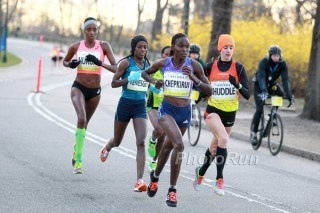
Three event records were broken on the streets of Manhattan at the 2016 United Airlines NYC Half on Sunday. Molly Huddle, an Elmira, NY, native, defended her title, beating Kenyan Joyce Chepkirui by eight hundredths of a second in a thrilling photo finish with a time of 1:07:41.
“I knew once I hit those final 150 meters, I just needed to sprint,” Huddle said. “I kind of was just trying to get my body across the line and not fall at the same time.”
Chepkirui was second for the second consecutive year, finishing a stride behind Huddle. In the men’s field, Kenyan Stephen Sambu took first place in 1:01:16, his first victory in the event after finishing second last year and third the year prior. Sambu was followed by runner-up and compatriot Wilson Chebet, who crossed the finish line 1:01:35, and Sam Chelanga of the U.S., who clocked in at 1:01:43.
Photo Gallery
1 of {count}
Back to Start
View Larger Image

2016 NYC Half Marathon
American Sam Chelanga celebrates his third place finish. Photo: PhotoRun.net
View Larger Image

2016 NYC Half Marathon
Joyce Chepkirui pushes the pace. Photo: PhotoRun.net
View Larger Image

2016 NYC Half Marathon
Joyce Chepkirui finished second in 1:07:41. Photo: PhotoRun.net
View Larger Image

2016 NYC Half Marathon
The lead women's packs follows Chepkirui's pace. Photo: PhotoRun.net
View Larger Image

2016 NYC Half Marathon
Top-3 women, left to right: Joyce Chepkirui (2nd), Molly Huddle (1st), Diane Nukuri (3rd). Photo: PhotoRun.net
View Larger Image

2016 NYC Half Marathon
Liz Costello runs strong. Photo: PhotoRun.net
View Larger Image

2016 NYC Half Marathon
Neely Spence Gracey is training for next month's Boston Marathon. Photo: PhotoRun.net
View Larger Image

2016 NYC Half Marathon
Huddle's winning time was a new event record. Photo: PhotoRun.net
View Larger Image

2016 NYC Half Marathon
The American record holder for 5,000m on the track, Huddle won here for the second straight year. Photo: PhotoRun.net
View Larger Image

2016 NYC Half Marathon
Huddle celebrates her victory in front of the finish line crowd. Photo: PhotoRun.net
View Larger Image

2016 NYC Half Marathon
Race winners Molly Huddle and Stephen Sambu hold up they trophies. Photo: PhotoRun.net
View Larger Image

2016 NYC Half Marathon
Huddle and Chepkirui were credited with the same time, but Huddle came away with the win. Photo: PhotoRun.net
View Larger Image

2016 NYC Half Marathon
Huddle and Chepkirui run side by side en route to the finish line. Photo: PhotoRun.net
View Larger Image
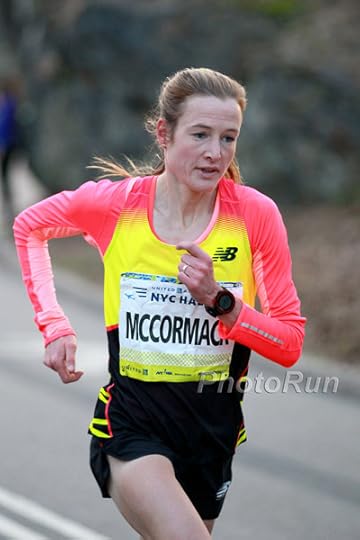
2016 NYC Half Marathon
Fionnuala McCormack. Photo: PhotoRun.net
View Larger Image

2016 NYC Half Marathon
Diane Nukuri ran strong to a third place finish. Photo: PhotoRun.net
View Larger Image

2016 NYC Half Marathon
Beverly Ramos. Photo: PhotoRun.net
View Larger Image

2016 NYC Half Marathon
Reigning Boston Marathon champion Caroline Rotich is prepping to defend her title next month. Photo: PhotoRun.net
View Larger Image

2016 NYC Half Marathon
Stephen Sambu breaks the finish line tape in style. Photo: PhotoRun.net
View Larger Image

2016 NYC Half Marathon
Etaferahu Temesgen. Photo: PhotoRun.net
View Larger Image

2016 NYC Half Marathon
Alisha Williams. Photo: PhotoRun.net
Related Galleries

Monday Motivation: 13 Funny Selfies For 13.1 Miles

More Galleries
The post Photos: Molly Huddle Triumphs In Close Finish at 2016 NYC Half Marathon appeared first on Competitor.com.
Ryan Hall's Blog
- Ryan Hall's profile
- 21 followers



